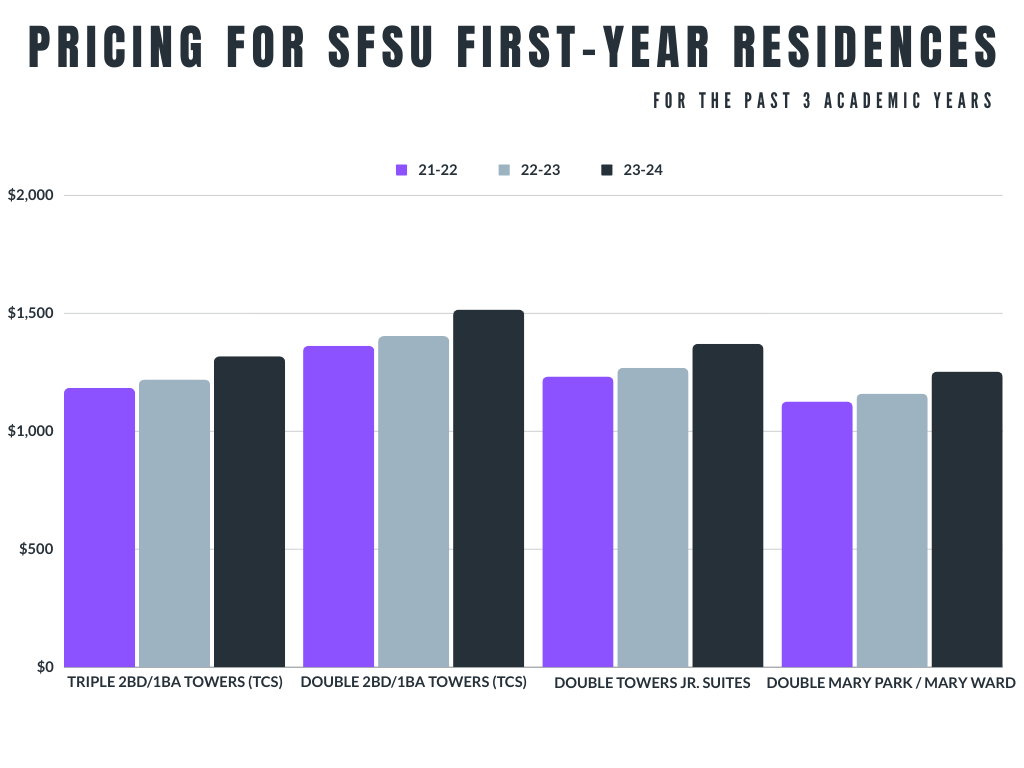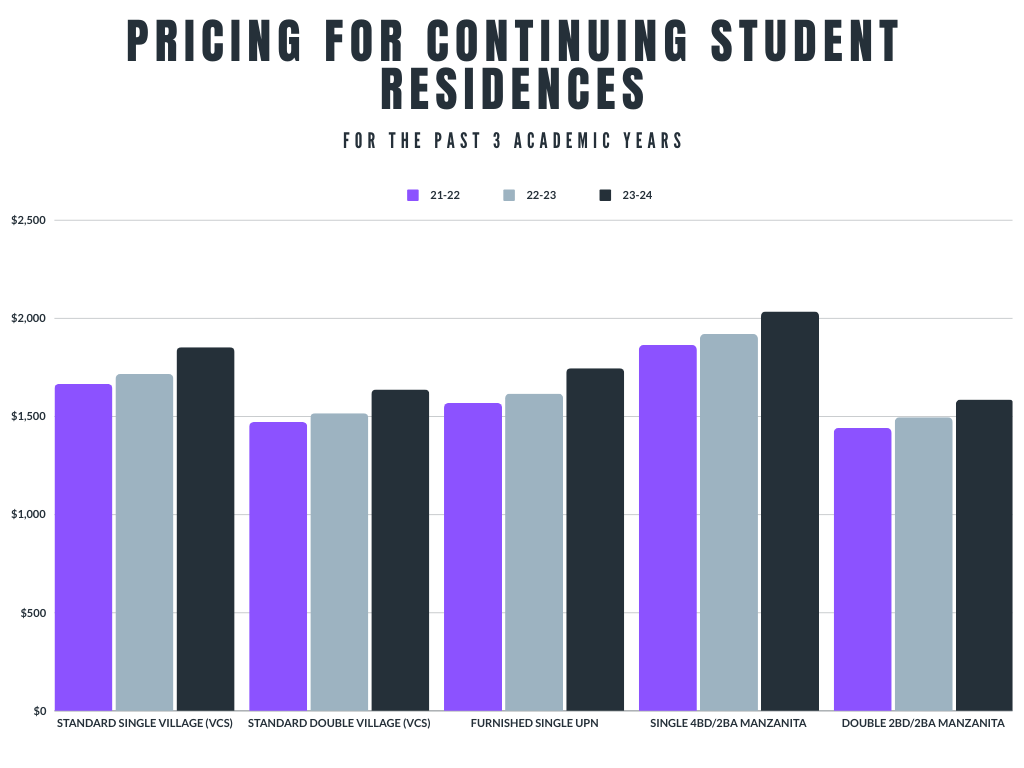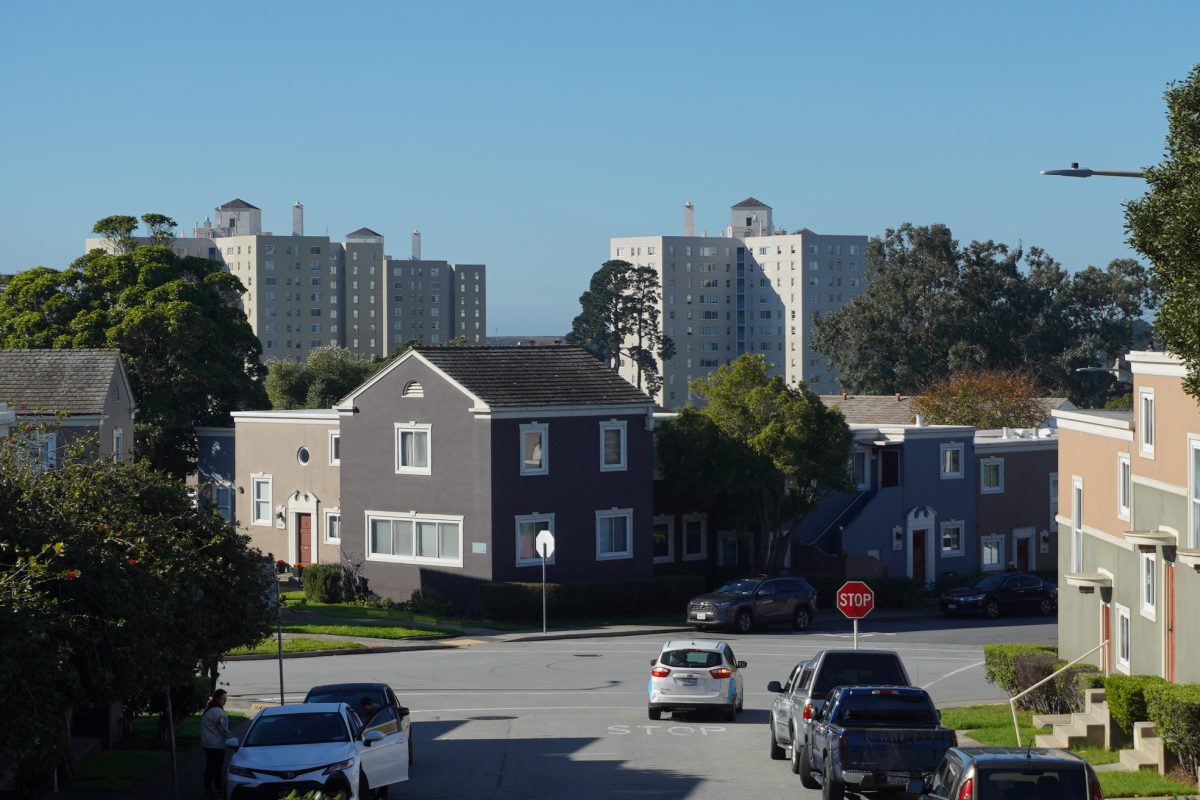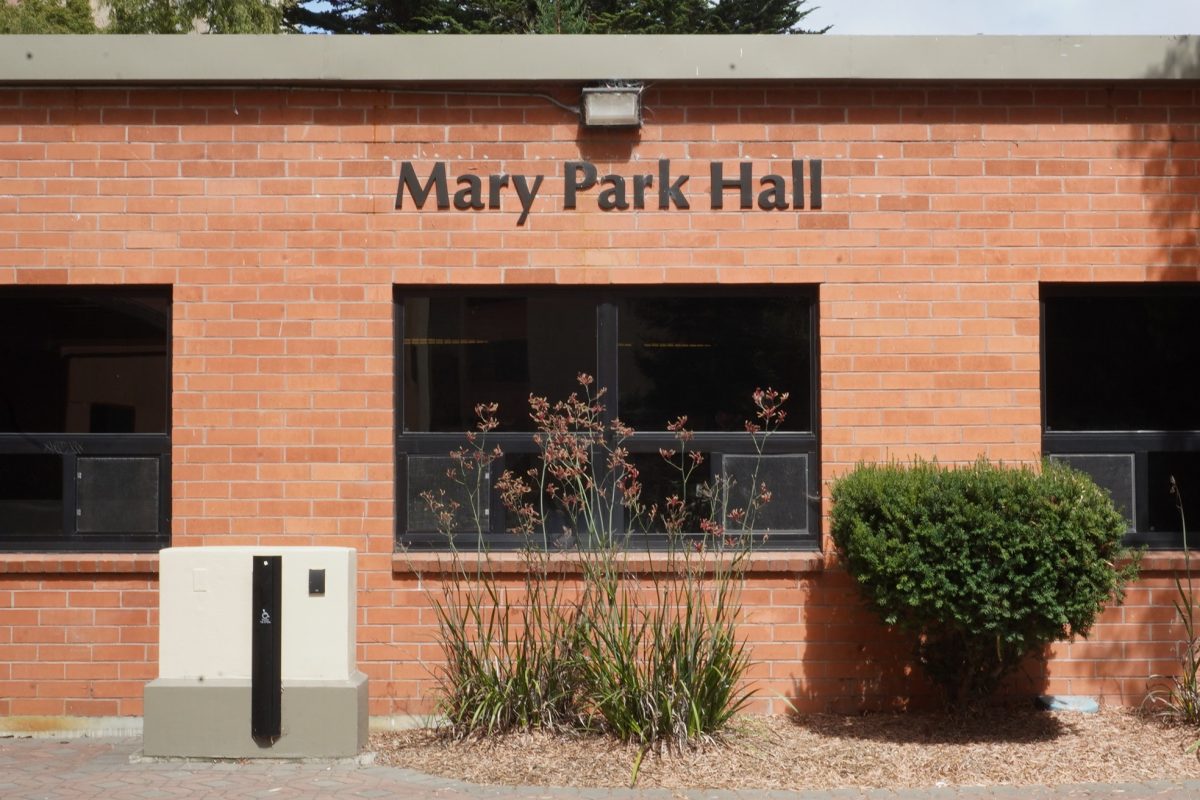In 2018, San Francisco State University announced the Future State Campus Master Plan 2035 with the intent to be able to house 12,500 students on campus; it housed approximately 3,500 at the time. Today, SFSU is a residence to around 4,200 students.
The University is experiencing historically low enrollment stemming from the COVID pandemic as fewer spring semester courses are being offered amidst lecturer-faculty layoffs.
Campus dorm prices are also up despite the decrease in students on campus. Amidst the changing campus landscape, future and existing students have a lot to consider when choosing to stay on campus or make the commute from their homes.
FACTORS BEHIND RISING DORM PRICES AND HOW LOW CAMPUS OCCUPANCY IMPACTS THE HOUSING BUDGET
The cost of SFSU dorms has increased from recent previous academic years despite the decrease in student enrollment. For example, the cost of a triple 2 BD/1 BA at Towers Centennial Square was $1,184 for the 2021-22 academic year, rose to $1,220 for the previous year and to $1,318 for the current year.
According to Residential Life Director David Rourke, university housing pricing has increased due to a combination of factors — San Francisco’s rising cost of living, an increase in SFSU’s cost of operations and low student enrollment.
The housing budget operates off the funds that come in from students paying rent. SFSU doesn’t receive any support from California for this budget, which has been impacted by a trend of fewer students in campus housing since the pandemic’s onset.

During the first year of the pandemic, campus occupancy was around 300 — mostly people who were unable to return home at that time. In the following years, occupancy increased to 75% and is currently at around 90%.
According to Rourke, CSU’s system-wide occupancy is approximately 93% and SFSU houses students below that average. The decline in enrollment has affected campus housing operations and has transformed the campus housing population.
SFSU plans to cut over 400 courses in the coming spring semester. The reduced number of classes offered adds to the factors that a potential future SFSU student has to consider when choosing what college offers to accept — how expensive the cost of living and rent is compared to their alternatives, and whether being a Gator is the right financial decision for them to make.
The University has typically been a residence for first-year students, but is now experiencing a trend going against that. Currently, the campus houses about 18% of the student body and is housing more continuing students than first-years.
A recent housing survey conducted by Residential Life highlighted the academic class standings of the participants. Out of the 1,118 responses — 34.8% were freshmen, 61% were continuing students and 4.2% were graduate and non-degree students.
For many continuing students currently in dorms, it’s their first time living on campus. The University was online during COVID-19 and didn’t return for in-person classes until Fall 2021, which was the first introduction for those who started attending SFSU during the pandemic.
Students who don’t live on-campus during their first year usually won’t seek campus housing options later on into their time at SFSU according to Rourke, who spoke about how low enrollment could impact housing populations in the future.
“People that, if they choose not to live on campus, we typically don’t capture them later on — there’s a very small percentage. So if they don’t live with us in their first year, they typically don’t live with us in the future,” Rourke said. “When we have smaller freshman classes, it means that we have smaller amounts of people that are living with us. Future housing populations are going to look perhaps a little bit smaller. So yeah, so it’s definitely, there’s an effect there for sure.”

UPGRADING UNIVERSITY HOUSING CAPACITY AND INFRASTRUCTURE, UTILIZING EXISTING SPACES TO CREATE MORE HOUSING
Over the past 20 years, the University has expanded campus size from around 90 acres to 258 acres, increasing its capacity to house students from approximately 300 to 4,200.
Most dorms on campus are outdated and in need of renovation. After the completion of West Campus Green, SFSU has plans for Mary Park and Ward buildings to be redeveloped to improve the infrastructure and raise their ability for higher occupancy.
The University’s approach to expanding campus size is by utilizing its existing spaces more effectively to accommodate the growing student demand for housing. The recent Manzanita Square and West Campus Green projects showcase that approach in action.
Before its construction, the site of Manzanita Square used to house only 27 units. The dorm now has an occupancy of 167 units, more than quintupling its capacity to house students. The tenants at the initial housing complex were all relocated to housing nearby.
The new West Campus Green dorm scheduled to open in Fall 2024 is another example of the University repurposing an existing space to address the needs for student housing — converting a soccer field into a dorm that can house 750 students, RAs and faculty, with the addition of a new dining hall and a new location for the health center.
The development was funded by California’s Affordable Student Housing grant program which provided the school with $116.3 million in funds to cover the project costs. In addition to 750 new beds at West Campus Green, the University is also introducing 750 affordable beds in first-year residences like Mary Park, Ward and Campus Green that are priced 25% less than its initial price.
According to Vice President of University Enterprises Jason Porth, the initiative is a first-of-its-kind where the state of California has put money into the cost of housing. Typically, statewide and countrywide models for housing have to be self-supported. He spoke about the significance of the grant and its ability to increase affordable housing options for SFSU students.
“Rather than have to take out the full cost of that mortgage, we’re going to give money to this [project] to lower the cost. We promised to bring 750 new first-year student beds online, and those will open in fall of 24. We didn’t want all 750 affordable beds to be in one community because that doesn’t create the type of diversity that we want to create in our communities.”
A few off-campus housing projects have been proposed and operating to address the demand for not only students but housing in general.
The University of California College of the Law, San Francisco recently opened a new campus residence downtown at 198 McAllister Street. The building, Academe at 198, is a 14-story-high building comprising 656 units for students of UC Law SF, UCSF, other universities, and community members. 230 of the units are below market rate.
UC Law SF is creating an academic village by inviting other schools and programs such as UCSF Medical School, University of the Pacific Dental School and SFSU to share this space with them. Students of these colleges are welcome to reside in this shared living space. Porth spoke about how UC Law SF utilized an existing space to redevelop into a shared housing space for its campus and college communities across San Francisco.
They [UC Law SF] used to have one building that was all housing and then the building next to it would be the classrooms. What UC Law has done is they’ve created a mixed-use building, where there’s a cafe on the ground floor [and] there’s shared academic spaces,” Porth said. “This is a unique approach to student housing where they’re saying, ‘Okay, we’ve got space, we’ll share it with other universities in the area.’”
Stonestown Galleria is a mall a few minutes away from campus and is set to be a site repurposed for housing. The Stonestown Development Project will transform the vast existing parking space at the mall into around 3500 housing units — with the addition of community spaces, offices, retail fronts, parks and more.
Stonestown is popular with the SFSU community. It’s within walking distance from campus where students can get food, hang out, go shopping and go to the movies — an option for students to consider if they choose to move off-campus near the mall, where they stay near the University and campus community.
CAMPUS HOUSING AND THE STUDENT EXPERIENCE – WHAT’S IT LIKE NOW AND WHAT COULD IT LOOK LIKE IN THE FUTURE?

At a recent Residential Housing Association (RHA) meeting on Nov. 14, students discussed campus housing issues such as meal plans, dorm facilities, the cost of housing and campus safety. Elevator safety, broken laundry machines and pests were some of the notable concerns voiced by students.
Newer residences like West Campus Green will have better facilities as they’re recently built, modern structures. According to Porth, adding more housing that’s affordable for students will increase SFSU’s enrollment and ability to retain existing students. This will make SFSU a more attractive college prospect for future students.
SFSU will focus on housing more first-year students as they seek to increase the percentage of the student body and freshmen residing on campus, who look forward to getting their first taste of college life. Raising occupancy to house more students will be key to building a larger campus residence community.
RHA President Francine Elayba spoke about her experience living on campus and why students may potentially choose to live in dorms despite not having much personal space.
“I feel like for freshmen, at least for me, I don’t really mind the space that much. Because I think the space comes in [to] factor for freshmen who would want people to be closer so that they have more community. I think most freshmen won’t bother about the space,” she said.
“Some students have a tendency of socializing more, so that could also be a factor for them to know more people and [they] can adjust faster on campus,” RHA Director of Communications Humaid Shams added.
The COVID pandemic led to lower numbers of student residents on campus at the time, the effects of which are being felt now in the form of higher dorm prices due to reduced money coming in from student housing rent.
SFSU and colleges like UC Law SF are coming up with creative ways to address the demand for student housing in the post-COVID world — shared living and redeveloping existing campus spaces into housing are some examples.
The university housing budget and prices are dependent on the number of campus residents. The cost of living could be the deciding factor for many potential students on whether they choose to be a Gator or choose to attend another school because on-campus housing is too expensive for them.
SFSU enrollment is currently low, however, Porth believes that more people will attend campus with the addition of affordable student housing.
“I firmly believe that when we add student housing that is affordable for our students, it will impact our ability to increase enrollment. And not just increase our enrollment for new students, but also increase our ability to retain our existing students,” Porth said. “If we can build affordable housing for our students, which is what we’re doing with West Campus Green, that’s going to help us with our enrollment, growth and our retention.”











NEAL WONG • Apr 11, 2024 at 1:30 am
WHY ARE THE HEADINGS ALL CAPS